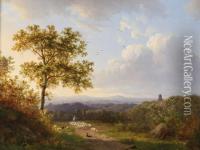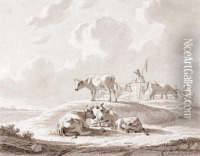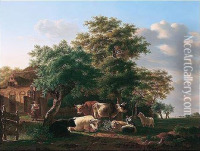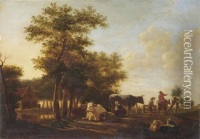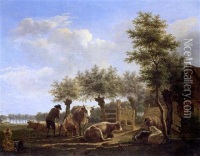Gillis Smak Gregoor Paintings
Gillis Smak Gregoor was a Dutch painter and draftsman, born in 1750 in Middelburg, the Netherlands. His work primarily falls into the period of the Dutch Golden Age's later years, a time when Dutch art was renowned for its attention to detail, depth of color, and realism. Despite being born into a period rich with artistic tradition, Gregoor's work is not as widely recognized as that of his contemporaries. However, his contributions to Dutch art, particularly in landscape and maritime painting, hold significance for their technical skill and atmospheric quality.
Gregoor's early life was steeped in an environment that nurtured his artistic talents. Middelburg, his birthplace, was a vibrant center for art and commerce during the 18th century, which undoubtedly influenced his decision to pursue painting. Little is documented about his formal education in art, but it was common during this time for young artists to apprentice with established painters, learning techniques and gaining exposure to various styles.
Throughout his career, Gregoor specialized in creating detailed landscapes and seascapes, capturing the essence of Dutch rural and coastal life with precision and sensitivity. His paintings often depicted serene scenes, imbued with a sense of calm and tranquility, which was characteristic of the period's artistic endeavors. Additionally, he occasionally ventured into portraiture and genre scenes, showcasing his versatility as an artist.
Despite his evident skill and the quality of his work, Gillis Smak Gregoor did not achieve the same level of fame as some of his contemporaries. The reasons for this are not entirely clear, but it could be attributed to the changing tastes in art during his lifetime, as well as the competitive nature of the art world in the Netherlands.
Gregoor's contributions to the Dutch art scene of the 18th century, while perhaps not as celebrated as those of some of his peers, remain valuable for their portrayal of the natural and social landscapes of the time. His work provides insight into the artistic trends and societal values of his era. Gregoor passed away in 1808, leaving behind a legacy that, though modest, is appreciated by art historians and collectors for its beauty and historical significance.





